Poto?nik P. (Ed.) Natural Gas
Подождите немного. Документ загружается.

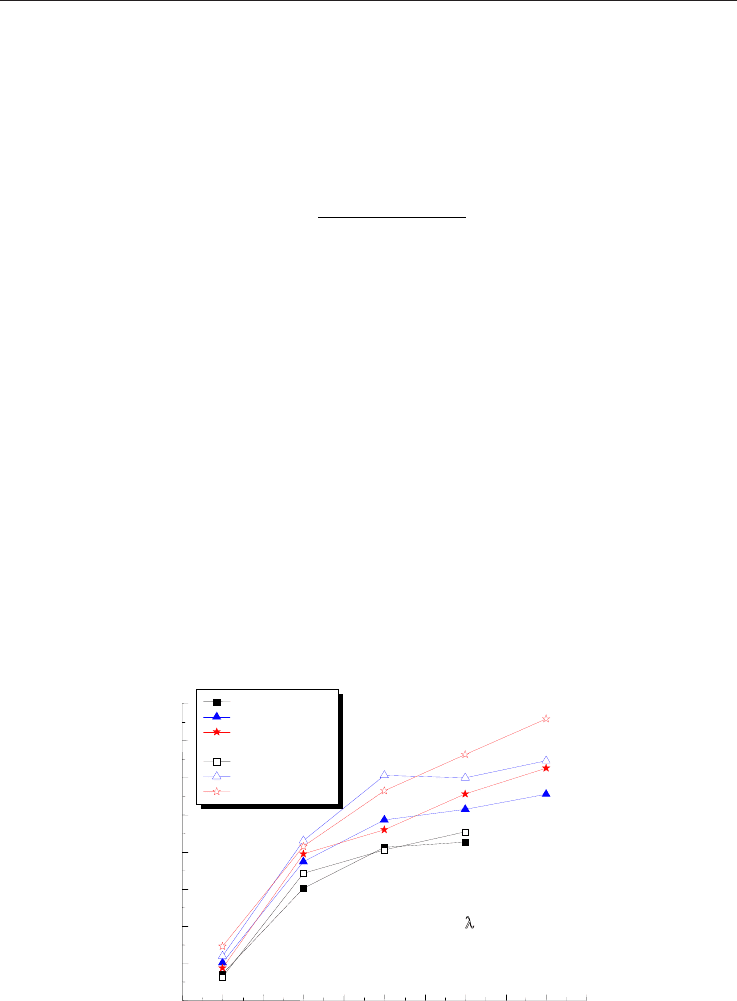
Hydrogen-enriched compressed natural gas as a fuel for engines 311
Fig. 1. Control logic of the on-line hydrogen/natural gas mixing system
6. Fundamental Equations
The chemical reactions of the fuel are essential in determining the amount of emissions the
fuel will produce. This section will introduce some fundamental equations related to HCNG.
Because CNG is made up of primarily methane, the following chemical equations are
assumed:
CH
4
� 2O
2
�
�
1 � �
�
CO
2
� 2H
2
O
(1)
H
2
�
1
2
O
2
� H
2
O
(2)
The fraction of hydrogen is x , and by assuming the molar mass of methane is 16 kg/mol
and the molar mass of H
2
is 2 kg/mol, the mass fraction becomes
� �
��
�
�
��
�
�
� �1 � ���
��
�
�
2�
2� � 1��1 � ��
�
�
� � ��
(3)
Assuming that the air is 23.2% oxygen, the stoichiometric air-fuel ratio for the
hydrogen/methane mixture is
�
�
� �4�4�
4 � ��
� � ��
(4)
In order to calculate the lower heating value, the following equation is used
ܪ
௨
ൌ ܪ
ு
మ
ݍ ܪ
ு
ర
ሺ
ͳ െ ݍ
ሻ
(5)
By substituting equation (3) and the relative heating values for hydrogen and methane
(assuming the lower heating value of methane is 120 MJ/kg and the lower heating value of
hydrogen is 50 MJ/kg), the following equation is formed with the units of MJ/kg.
ܪ
௨
ൌ
ͳʹͲݔ ͷͲሺͺ െ ͺݔሻ
ͺ െ ݔ
(6)
7. Performance Characteristics
Performance plays an important role in the choice of a fuel. HCNG has many advantages
when it comes to performance because of the high octane number of hydrogen, the engine
performance generally increases with the addition of hydrogen. The transient performance
is also very important because in most cases the car will be running in transient conditions,
this is covered in more detail by Ma et al. (2009b).
The thermal efficiency of both natural gas and HCNG increases with increasing load, which
makes it an ideal fuel for high load applications and heavy-duty vehicles, this relationship
can be seen in figure 2. It is also clearly seen in figure 2 that in nearly every case, the HCNG
fuel has a higher thermal efficiency than pure natural gas. The results show that the brake
effective thermal efficiency increases with an increased percentage of hydrogen at low and
medium loads. The increase in thermal efficiency with the hydrogen addition is due to the
reduction in the equivalence ratio. The hydrogen addition allows the lean burn limit to be
extended because of the fast burn rate of hydrogen. The fast burn rate of hydrogen causes
the combustion duration to decreases while the heat release rate and exhaust NOx increase
with an increased percentage of hydrogen.
Fig. 2. Indicated thermal efficiency at the maximum brake torque spark timing
140
40
50
60
70
80
90
100
110
120
130
0.26
0.28
0.30
0.32
0.34
0.36
0.38
0.40
0.42
=1.5,
MBT spark timing
CNG, 800rpm
CNG, 1600rpm
CNG, 2400rpm
30% H
2
, 800rpm
30% H
2
, 1600rpm
30% H
2
, 2400rpm
Load (kPa)
Indicated Thermal Efficiency
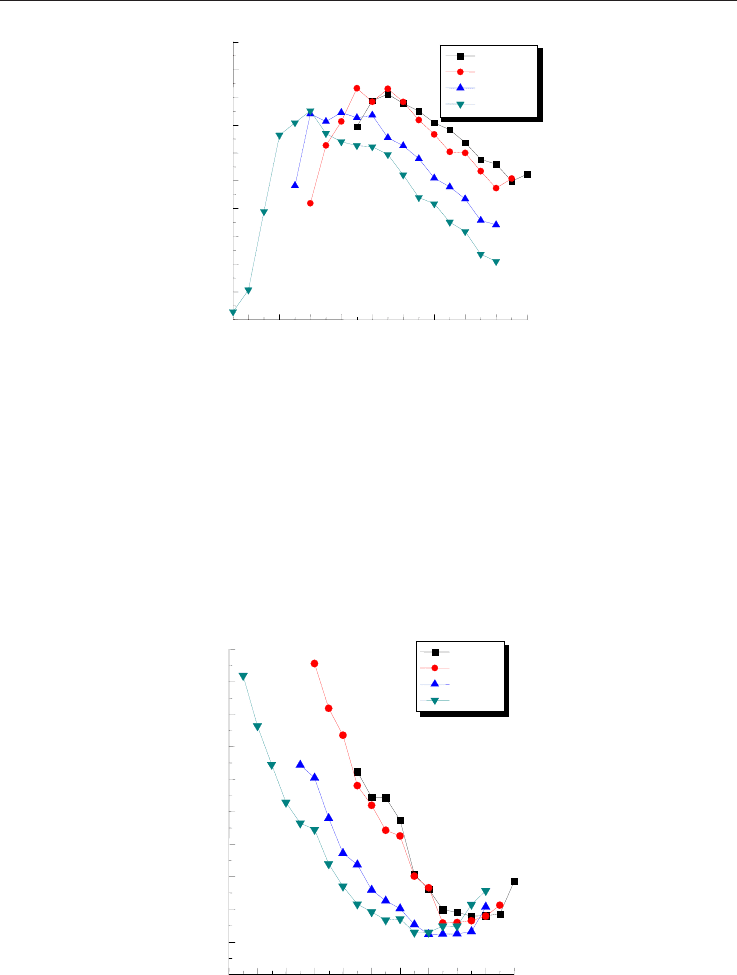
Natural Gas312
Fig. 3. Variation in the maximum pressure for various spark timings
The cycle-by cycle variations are also reduced with the addition of hydrogen, figures 3 and 4
show graphs of the coefficient of variation in the maximum pressure and indicated mean
effective pressure respectively, for different hydrogen ratios. It can be seen that the
coefficient of variation is reduced with an increased percentage of hydrogen at lean burn
operation. The torque drop caused by retarded spark timing is relatively smaller in the case
of HCNG fueling compared to that of CNG fueling, which can be seen in figure 5. This
makes it possible to further retard the spark timing in an HCNG engine which results in
lower NOx emissions. A higher torque also has other advantages such as resulting in a
lower brake specific fuel consumption which is shown in figure 6.
Fig. 4. Variation in the indicated mean effective pressure for various spark timings
COV in IMEP
(
%
)
0 4 8 12 16 20 24 28 32 36 40
5.0
Spark Timing( °CA BTDC)
CNG
0.0
0.5
1.0
1.5
2.0
2.5
3.0
3.5
4.0
4.5
ࣅ =1.5
1600 rpm
MAP= 125 kPa
15% H
2
30% H
45% H
2
2
4 8 12
16 20
24 28
32 36
40
0
1
2
3
4
5
6
7
8
9
10
ࣅ =1.5
1600 rpm
MAP= 125 kPa
CNG
15% H
2
30% H
45% H
2
Spark Timing( °CA BTDC)
2
COV in Pmax (%)
Fig. 5. Torque output for various H/CNG ratios (ͳʹͲͲݎ݉ǡ ߣ ൌ ͳǤ͵ሻ (Ma et al., 2009a)
When two fuels with identical lower heating values are used, the fuel with the higher torque
output will have lower brake specific fuel consumption (BSFC). According to the rules of
lower heating value equivalent transformation, the mass of hydrogen in the HCNG fuel can
be converted to a CNG mass with an equal lower heating value; this mass can then be added
to the mass of CNG in the HCNG blend, therefore calculating an equivalent CNG mass.
Using this equivalent data, the BSFC of HCNG and CNG can be compared and is shown in
figure 6. (Ma et al., 2009a) It can be seen that the BSFC of the HCNG fuel is lower than the
BSFC of pure CNG in nearly every case.
Fig. 6. Brake Specific Fuel Consumption for various H/CNG ratiosሺͳʹͲͲݎ݉ǡ ߣ ൌ ͳǤ͵ሻ (Ma
et al., 2009a)
8. Emission Characteristics
When it comes to alternative fuels, arguably the most important factor in determining the
feasibility of the fuel is the exhaust emissions. Because of the strictly controlled emissions
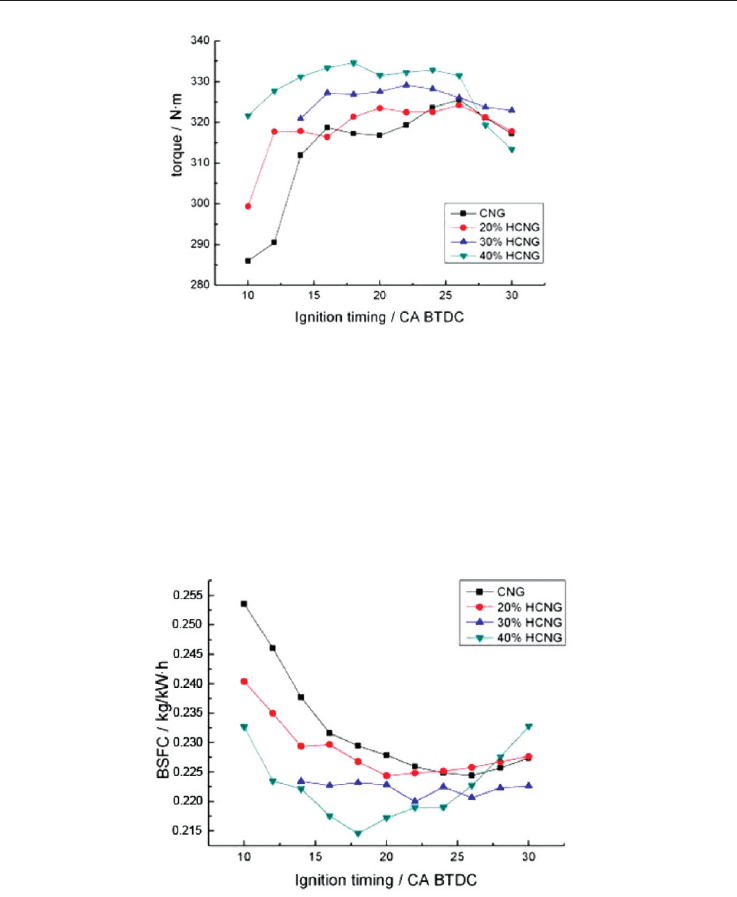
Hydrogen-enriched compressed natural gas as a fuel for engines 313
Fig. 3. Variation in the maximum pressure for various spark timings
The cycle-by cycle variations are also reduced with the addition of hydrogen, figures 3 and 4
show graphs of the coefficient of variation in the maximum pressure and indicated mean
effective pressure respectively, for different hydrogen ratios. It can be seen that the
coefficient of variation is reduced with an increased percentage of hydrogen at lean burn
operation. The torque drop caused by retarded spark timing is relatively smaller in the case
of HCNG fueling compared to that of CNG fueling, which can be seen in figure 5. This
makes it possible to further retard the spark timing in an HCNG engine which results in
lower NOx emissions. A higher torque also has other advantages such as resulting in a
lower brake specific fuel consumption which is shown in figure 6.
Fig. 4. Variation in the indicated mean effective pressure for various spark timings
COV in IMEP
(
%
)
0 4 8 12 16 20 24 28 32 36 40
5.0
Spark Timing( °CA BTDC)
CNG
0.0
0.5
1.0
1.5
2.0
2.5
3.0
3.5
4.0
4.5
ࣅ =1.5
1600 rpm
MAP= 125 kPa
15% H
2
30% H
45% H
2
2
4 8 12
16 20
24 28
32 36
40
0
1
2
3
4
5
6
7
8
9
10
ࣅ =1.5
1600 rpm
MAP= 125 kPa
CNG
15% H
2
30% H
45% H
2
Spark Timing( °CA BTDC)
2
COV in Pmax (%)
Fig. 5. Torque output for various H/CNG ratios (ͳʹͲͲݎ݉ǡ ߣ ൌ ͳǤ͵ሻ (Ma et al., 2009a)
When two fuels with identical lower heating values are used, the fuel with the higher torque
output will have lower brake specific fuel consumption (BSFC). According to the rules of
lower heating value equivalent transformation, the mass of hydrogen in the HCNG fuel can
be converted to a CNG mass with an equal lower heating value; this mass can then be added
to the mass of CNG in the HCNG blend, therefore calculating an equivalent CNG mass.
Using this equivalent data, the BSFC of HCNG and CNG can be compared and is shown in
figure 6. (Ma et al., 2009a) It can be seen that the BSFC of the HCNG fuel is lower than the
BSFC of pure CNG in nearly every case.
Fig. 6. Brake Specific Fuel Consumption for various H/CNG ratiosሺͳʹͲͲݎ݉ǡ ߣ ൌ ͳǤ͵ሻ (Ma
et al., 2009a)
8. Emission Characteristics
When it comes to alternative fuels, arguably the most important factor in determining the
feasibility of the fuel is the exhaust emissions. Because of the strictly controlled emissions
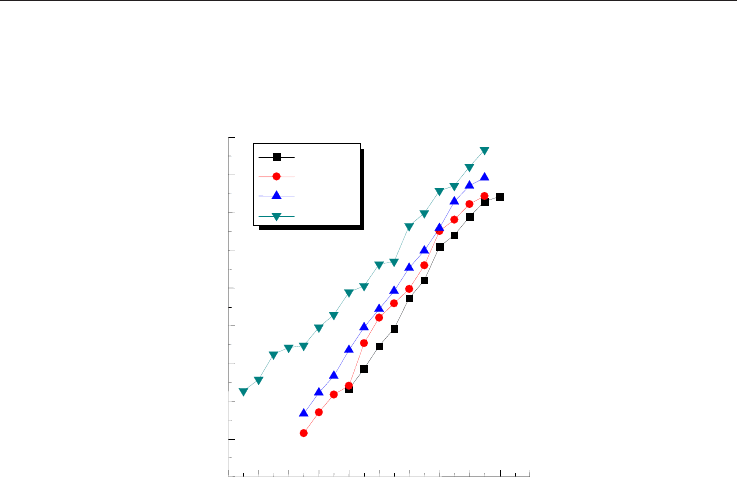
Natural Gas314
regulations, it is not only necessary to find a fuel that has optimum performance, but it is
also very important to find a fuel that can meet the respective emissions standards.
Fig. 7. Brake specific NOx emissions for different hydrogen fractions
Considering emissions, when HCNG fuel is compared with gasoline and diesel it appears to
be a very appealing alternative fuel. When compared to gasoline, it produces significantly
less nitrous oxide, carbon monoxide, carbon dioxide and non-methane emissions. And when
compared with diesel, it nearly eliminates the particulate matter which is often of great
concern. Compared to pure natural gas, it has been concluded that the addition of hydrogen
increases the NOx emissions while reducing the HC emissions. The combustion stability is
also improved by the addition of hydrogen which plays a part in reducing the un-burnt
hydrocarbon emissions.
NOx emissions versus ignition timing were plotted in figure 7. As can be seen from the
figure, the NOx emissions for the HCNG fuel are greater than the emissions of pure CNG.
This is because of the elevated flame temperature due to the hydrogen. However, the NOx
emissions of the HCNG are still considered relatively low compared to other fuels, and can
be adjusted with further optimization.
Figure 8 indicates the variation of specific brake hydrocarbon emission versus spark timing
for HCNG fuel at different ratios of hydrogen. As can be seen from the figure, the
hydrocarbon emissions for HCNG fueling are greatly reduced compared to natural gas. The
main reason for the decrease in hydrocarbon emissions is that the addition of hydrogen
increases the laminar flame speed which decreases the amount of unburned hydrocarbons
in the exhaust. Also, methane has a relatively stable chemical structure, therefore making it
difficult to reduce emissions by after treatment. For this reason, the engine fueled with
0 4 8 12 16 20 24 28 32 36 40
0
5
10
15
20
25
30
35
40
45
CNG
15% H
2
30% H
2
45% H
2
Spark Timing (°CA BTDC)
ࣅ=1.3
1600 rpm
MAP=125 kPa
Brake Specific NOx (g/kW·h)
HCNG has a large advantage regarding the hydrocarbon emissions than that of CNG
fueling.
Fig. 8. Brake specific hydrocarbons at different hydrogen fractions
9. Optimization
There are many methods to optimize the engine for performance and emissions based on
the properties of the fuel. Although the exhaust emissions from hydrogen-enriched natural
gas are already very low, further refinement must be done in order to further reduce
emissions and to achieve Enhanced Environmentally Friendly Vehicle (EEV) standards.
There are many methods to improve the emission output as well as improving the
performance of the engine.
9.1 Lean Burn
Lean burn characteristics are ideal in a fuel, because by running a fuel with a larger excess air
ratio can not only reduce the emissions, especially NOx, but can also offers advantages in other
areas such as reducing the brake specific fuel consumption. The lean burn limit is increased by
the addition of hydrogen because of the faster burn speed as well as the improved laminar
burn properties of hydrogen which makes it an ideal fuel to be run on lean-burn conditions.
Ma et al. (2008d) specifically investigates the lean burn limit of HCNG.
Probably the largest advantage to running the engine on lean burn, is that it has the ability
to greatly reduce the NOx emissions. The reduction in NOx emissions are due to the
increased airflow which causes the engine to run at a lower temperature, therefore reducing
the NOx emissions. Figure 9 shows how the NOx emissions are reduced at different excess
air-ratios. It is very clear from this figure that as the excess air ratio is increased the NOx
emissions drop considerably.
0 4 8 12 16 20 24 28 32 36 40
0.0
0.2
0.4
0.6
0.8
1.0
1.2
1.4
1.6
1.8
2.0
2.2
2.4
2.6
CNG
15% H
2
30% H
2
45% H
2
ࣅ=1.5
1600 rpm
MAP=125 kPa
Spark Timing ( °CA BTDC)
Brake Specific Hydrocarbons (g/kW·h)
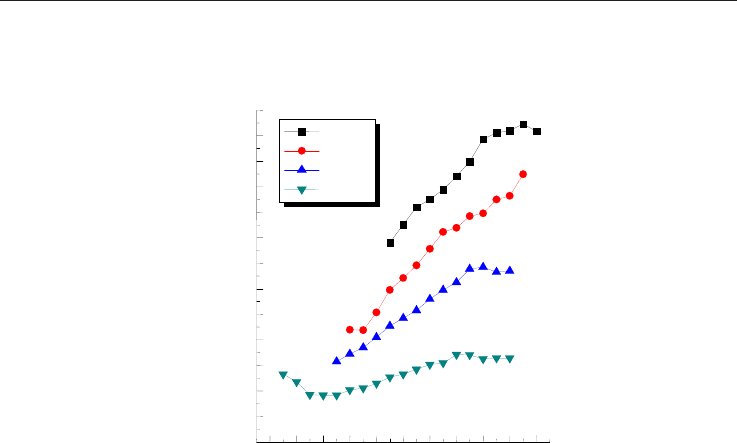
Hydrogen-enriched compressed natural gas as a fuel for engines 315
regulations, it is not only necessary to find a fuel that has optimum performance, but it is
also very important to find a fuel that can meet the respective emissions standards.
Fig. 7. Brake specific NOx emissions for different hydrogen fractions
Considering emissions, when HCNG fuel is compared with gasoline and diesel it appears to
be a very appealing alternative fuel. When compared to gasoline, it produces significantly
less nitrous oxide, carbon monoxide, carbon dioxide and non-methane emissions. And when
compared with diesel, it nearly eliminates the particulate matter which is often of great
concern. Compared to pure natural gas, it has been concluded that the addition of hydrogen
increases the NOx emissions while reducing the HC emissions. The combustion stability is
also improved by the addition of hydrogen which plays a part in reducing the un-burnt
hydrocarbon emissions.
NOx emissions versus ignition timing were plotted in figure 7. As can be seen from the
figure, the NOx emissions for the HCNG fuel are greater than the emissions of pure CNG.
This is because of the elevated flame temperature due to the hydrogen. However, the NOx
emissions of the HCNG are still considered relatively low compared to other fuels, and can
be adjusted with further optimization.
Figure 8 indicates the variation of specific brake hydrocarbon emission versus spark timing
for HCNG fuel at different ratios of hydrogen. As can be seen from the figure, the
hydrocarbon emissions for HCNG fueling are greatly reduced compared to natural gas. The
main reason for the decrease in hydrocarbon emissions is that the addition of hydrogen
increases the laminar flame speed which decreases the amount of unburned hydrocarbons
in the exhaust. Also, methane has a relatively stable chemical structure, therefore making it
difficult to reduce emissions by after treatment. For this reason, the engine fueled with
0 4 8 12 16 20 24 28 32 36 40
0
5
10
15
20
25
30
35
40
45
CNG
15% H
2
30% H
2
45% H
2
Spark Timing (°CA BTDC)
ࣅ=1.3
1600 rpm
MAP=125 kPa
Brake Specific NOx (g/kW·h)
HCNG has a large advantage regarding the hydrocarbon emissions than that of CNG
fueling.
Fig. 8. Brake specific hydrocarbons at different hydrogen fractions
9. Optimization
There are many methods to optimize the engine for performance and emissions based on
the properties of the fuel. Although the exhaust emissions from hydrogen-enriched natural
gas are already very low, further refinement must be done in order to further reduce
emissions and to achieve Enhanced Environmentally Friendly Vehicle (EEV) standards.
There are many methods to improve the emission output as well as improving the
performance of the engine.
9.1 Lean Burn
Lean burn characteristics are ideal in a fuel, because by running a fuel with a larger excess air
ratio can not only reduce the emissions, especially NOx, but can also offers advantages in other
areas such as reducing the brake specific fuel consumption. The lean burn limit is increased by
the addition of hydrogen because of the faster burn speed as well as the improved laminar
burn properties of hydrogen which makes it an ideal fuel to be run on lean-burn conditions.
Ma et al. (2008d) specifically investigates the lean burn limit of HCNG.
Probably the largest advantage to running the engine on lean burn, is that it has the ability
to greatly reduce the NOx emissions. The reduction in NOx emissions are due to the
increased airflow which causes the engine to run at a lower temperature, therefore reducing
the NOx emissions. Figure 9 shows how the NOx emissions are reduced at different excess
air-ratios. It is very clear from this figure that as the excess air ratio is increased the NOx
emissions drop considerably.
0 4 8 12 16 20 24 28 32 36 40
0.0
0.2
0.4
0.6
0.8
1.0
1.2
1.4
1.6
1.8
2.0
2.2
2.4
2.6
CNG
15% H
2
30% H
2
45% H
2
ࣅ=1.5
1600 rpm
MAP=125 kPa
Spark Timing ( °CA BTDC)
Brake Specific Hydrocarbons (g/kW·h)
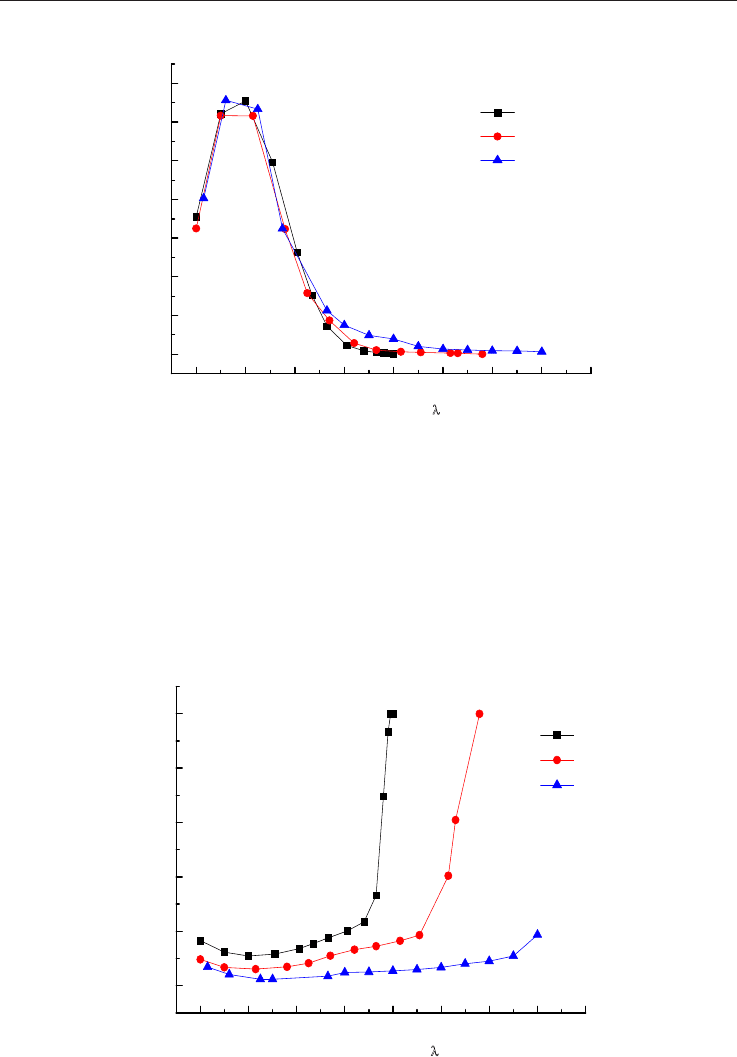
Natural Gas316
1.0 1.2 1.4 1.6 1.8 2.0 2.2 2.4 2.6
0
1000
2000
3000
4000
5000
6000
7000
n=1200rpm MAP=105kPa MBT spark timing
NO
X
concentration /ppm
Excess air ratio
0% H
2
30% H
2
55% H
2
Fig. 9. The effect of excess air ratio vs NOx at MBT spark timing
The effect of the excess air ratio on hydrocarbon emissions can be seen in figure 10. It can be
seen from the figure that there is a small reduction at an air-fuel ratio of roughly 1.25, but as
the excess air ratio increases even further, the hydrocarbon emissions also increase. The
reduction in hydrocarbon emissions at an excess air ratio of around 1.25 is not as evident in
the hydrocarbon emissions as it was in the nitrous oxide emissions because as more air is
added it can also contribute to unstable combustion which can also contribute to more
unburned hydrocarbons. An increased excess air ratio can also increase the cycle-by-cycle
variations which causes poor running conditions.
1.0 1.2 1.4 1.6 1.8 2.0 2.2 2.4 2.6
0
2000
4000
6000
8000
10000
n=1200rpm MAP=105kPa MBT spark timing
CH
4
concentration /ppm
Excess air ratio
0H
2
30H
2
55H
2
Fig. 10. Hydrocarbon Emissions for different hydrogen fractions and excess air ratios
Carbon monoxide emissions should also be considered when selecting the ideal excess air
ratio. As seen in figure 11, by increasing the excess air ratio the carbon monoxide emissions
drop dramatically. This occurs because the formation of carbon monoxide is mainly caused
by incomplete combustion. However, as the excess air ratio becomes too large the
combustion conditions are reduced and the carbon monoxide emissions begin to increase.
Another advantage to lean burn is that as the excess air ratio is increased, the brake specific
fuel consumption decreases. This is because as the air-fuel ratio is increased, it usually
leaves less unburned fuel. That is true until the excess air ratio reaches a certain limit when
the cycle-by-cycle variations begin to increase because of the lack of fuel. Lean operation
also reduces the likelihood of knocking, which allows the use of a higher compression ratio.
However, there are some difficulties with lean-burn operation including cycle-by-cycle
variations. Cycle-by-cycle variations, which increase as the engine is leaned-out, are
generally recognized as a limiting factor for the engine’s stable operation, fuel efficiency and
emissions. Lean operation can decrease the CO and NOx emissions while simultaneously
improving engine efficiency. A compromise must be made so that significant reduction in
emissions can be made without sacrificing the burn quality of the fuel which may include
slow flame propagation, increased cycle by cycle variations and incomplete combustion
which may be more clearly explained in Ma et al. (2008a), Ma et al. (2008e) and Ma et al.
(2008f).
1.0 1.2 1.4 1.6 1.8 2.0 2.2 2.4 2.6
0
500
1000
1500
2000
2500
3000
3500
4000
4500
n=1200rpm MAP=105kPa MBT spark timing
CO concentration /ppm
Excess air ratio
0% H
2
30% H
2
55% H
2
Fig. 11. Carbon Monoxide emissions vs excess air ratio
9.2 Hydrogen Ratio
The addition of hydrogen can greatly improve the performance and emissions of the fuel.
There have been many studies completed in efforts to obtain the ideal hydrogen ratio, and
the general consensus is that hydrogen/natural gas blends around 20%, results in the best
overall combination of emissions and engine performance. According to Wang (2009a), the
role of hydrogen in the ame will change from an intermediate species to a reactant when
hydrogen fraction in the blends exceeds 20%. (Wang et al., 2009a) Consequently the most
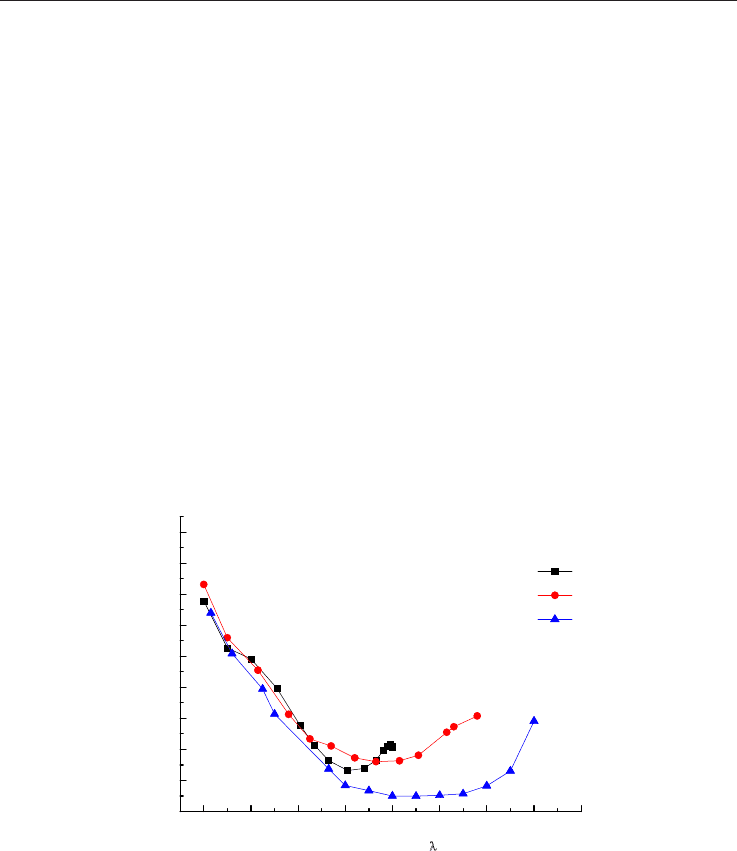
Hydrogen-enriched compressed natural gas as a fuel for engines 317
1.0 1.2 1.4 1.6 1.8 2.0 2.2 2.4 2.6
0
1000
2000
3000
4000
5000
6000
7000
n=1200rpm MAP=105kPa MBT spark timing
NO
X
concentration /ppm
Excess air ratio
0% H
2
30% H
2
55% H
2
Fig. 9. The effect of excess air ratio vs NOx at MBT spark timing
The effect of the excess air ratio on hydrocarbon emissions can be seen in figure 10. It can be
seen from the figure that there is a small reduction at an air-fuel ratio of roughly 1.25, but as
the excess air ratio increases even further, the hydrocarbon emissions also increase. The
reduction in hydrocarbon emissions at an excess air ratio of around 1.25 is not as evident in
the hydrocarbon emissions as it was in the nitrous oxide emissions because as more air is
added it can also contribute to unstable combustion which can also contribute to more
unburned hydrocarbons. An increased excess air ratio can also increase the cycle-by-cycle
variations which causes poor running conditions.
1.0 1.2 1.4 1.6 1.8 2.0 2.2 2.4 2.6
0
2000
4000
6000
8000
10000
n=1200rpm MAP=105kPa MBT spark timing
CH
4
concentration /ppm
Excess air ratio
0H
2
30H
2
55H
2
Fig. 10. Hydrocarbon Emissions for different hydrogen fractions and excess air ratios
Carbon monoxide emissions should also be considered when selecting the ideal excess air
ratio. As seen in figure 11, by increasing the excess air ratio the carbon monoxide emissions
drop dramatically. This occurs because the formation of carbon monoxide is mainly caused
by incomplete combustion. However, as the excess air ratio becomes too large the
combustion conditions are reduced and the carbon monoxide emissions begin to increase.
Another advantage to lean burn is that as the excess air ratio is increased, the brake specific
fuel consumption decreases. This is because as the air-fuel ratio is increased, it usually
leaves less unburned fuel. That is true until the excess air ratio reaches a certain limit when
the cycle-by-cycle variations begin to increase because of the lack of fuel. Lean operation
also reduces the likelihood of knocking, which allows the use of a higher compression ratio.
However, there are some difficulties with lean-burn operation including cycle-by-cycle
variations. Cycle-by-cycle variations, which increase as the engine is leaned-out, are
generally recognized as a limiting factor for the engine’s stable operation, fuel efficiency and
emissions. Lean operation can decrease the CO and NOx emissions while simultaneously
improving engine efficiency. A compromise must be made so that significant reduction in
emissions can be made without sacrificing the burn quality of the fuel which may include
slow flame propagation, increased cycle by cycle variations and incomplete combustion
which may be more clearly explained in Ma et al. (2008a), Ma et al. (2008e) and Ma et al.
(2008f).
1.0 1.2 1.4 1.6 1.8 2.0 2.2 2.4 2.6
0
500
1000
1500
2000
2500
3000
3500
4000
4500
n=1200rpm MAP=105kPa MBT spark timing
CO concentration /ppm
Excess air ratio
0% H
2
30% H
2
55% H
2
Fig. 11. Carbon Monoxide emissions vs excess air ratio
9.2 Hydrogen Ratio
The addition of hydrogen can greatly improve the performance and emissions of the fuel.
There have been many studies completed in efforts to obtain the ideal hydrogen ratio, and
the general consensus is that hydrogen/natural gas blends around 20%, results in the best
overall combination of emissions and engine performance. According to Wang (2009a), the
role of hydrogen in the ame will change from an intermediate species to a reactant when
hydrogen fraction in the blends exceeds 20%. (Wang et al., 2009a) Consequently the most
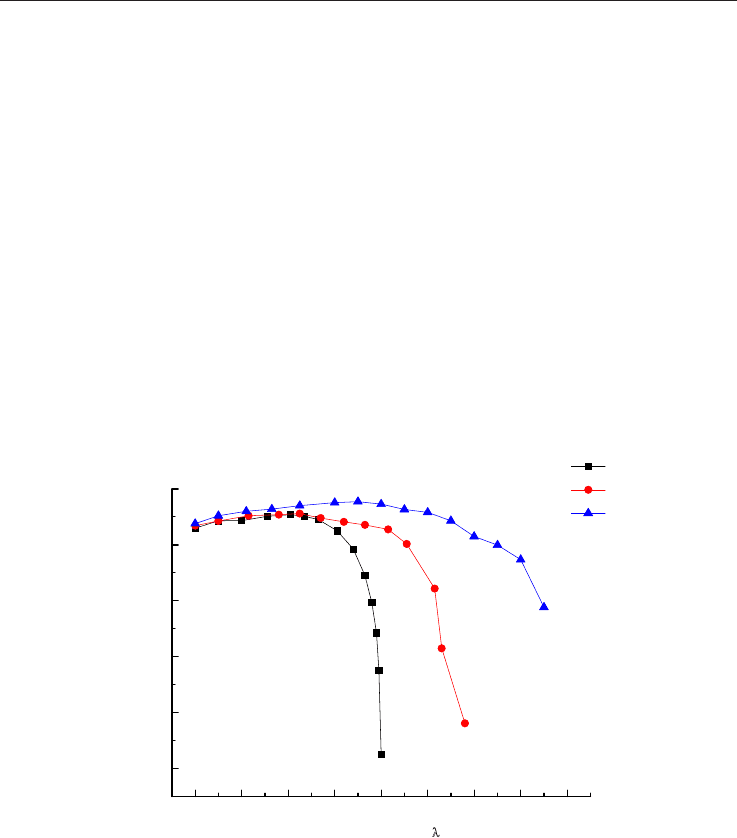
Natural Gas318
suitable hydrogen fraction is significantly related to ignition timing and excess air ratio.
According to Akansu et al. (2004) who completed tests on a single cylinder AVL engine at
hydrogen/natural gas ratio ranging from 0% to 100%, a 20–30% hydrogen enrichment of
natural gas gives the most favorable engine operation. Higher hydrogen contents
undermine the knock resistance characteristics of natural gas, lower power output of the
engine and increase the fuel cost. Akansu et al. also concludes that, Hydrogen content lower
than 20–30% does not make enough use of the performance enhancement potential of
hydrogen. (Akansu et al., 2004)
The thermal efficiency of fuel can be improved as seen in figure 2 from a previous section
and figure 12 of this section. Also seen in figure 12, the thermal efficiency begins to drop
rapidly after reaching a certain excess air ratio, for which this decline in thermal efficiency
can be reduced as the hydrogen ratio is increased. This is due to the improvements in
burning velocity and improvements in the combustion characteristics which can help extend
the lean burn limit and also improve the fuel efficiency. It can be seen in figure 6 that the
BSFC of the HCNG fuel can be reduced by increasing the ratio of hydrogen. The minimum
BSFC was attained using 40% HCNG, which results in a 5.07% lower BSFC than that of CNG
fueling at the same conditions.
1.0 1.2 1.4 1.6 1.8 2.0 2.2 2.4 2.6
0.15
0.20
0.25
0.30
0.35
0.40
Indicated thermal efficiency
Excess air ratio
0%
30
%
55
%
n=1200rpm MAP=105kPa MBT spark timing
Fig. 12. Indicated thermal efficiency versus excess air ratio
Under idle operation conditions, hydrogen addition is an effective method for improving
the power output of the engine and reducing both exhaust emissions and fuel consumption.
Furthermore, these results improve as the ratio of hydrogen is increased; however, studies
show that under ideal conditions there is not significant improvement when increasing the
hydrogen ratio in the HCNG fuel. Under normal operation conditions, the addition of
hydrogen is effective at improving the power output of the engine and reducing fuel
consumption. The hydrogen-enriched fuel can help improve the burning velocity and
improve the incomplete combustion and is seen to increase with the hydrogen ratio. Even
though the volumetric calorific value of the HCNG mixture is slightly lower than the
calorific value of pure CNG, after the fuel is enriched with hydrogen the combustion
efficiency and thermal power conversion efficiency are enhanced resulting in a higher
power performance as can be seen in figure 13.
1.0 1.2 1.4 1.6 1.8 2.0 2.2 2.4 2.6
10
20
30
40
50
60
n=1200rpm MAP=105kPa MBT spark timing
power output /kw
Excess air ratio
0% H
2
30% H
2
55% H
2
Fig. 13. Engine’s power performance versus excess air ratio
Figure 3 and figure 4 from a previous section show that the hydrogen addition can also be
an effective method to reduce the as coefficient of variation decreases. Cycle by cycle
variations are caused by poor burn quality and have many adverse effects such increasing
the emissions and reducing the performance. As the hydrogen fraction is increased, the
output torque also increases which can be seen in figure 5. According to Ma, et al. (2009a)
this is true at high engine speeds, but for low engine speeds the variation in torque is
negligible. Figure 14 shows the coefficient of variation of the indicated mean effective
pressure for different hydrogen ratios at different excess air ratios. As can be seen, hydrogen
addition can reduce COV
imep
especially when compared at high excess air ratios due to
hydrogen’s broader burn limit and its’ fast burn speed.
NOx emissions versus ignition timing were plotted in figure 7 of a previous section. As can
be seen from the figure, the NOx emissions increase as the hydrogen ratio increase. This is
caused by the elevated flame temperature in the cylinder which rises as the hydrogen is
added. Carbon monoxide emissions can also be greatly reduced with the addition of
hydrogen. Table 2 shows different hydrogen fractions while holding the power constant, it
is clearly seen in this table that as the hydrogen fraction is increased the carbon monoxide
and unburned hydrocarbon emissions are greatly reduced while the NOx remains at
acceptable levels. The reduction in hydrocarbon and carbon monoxide emissions can be
attributed to hydrogen’s ability to strengthen combustion, especially for lean fuel-air
mixtures.
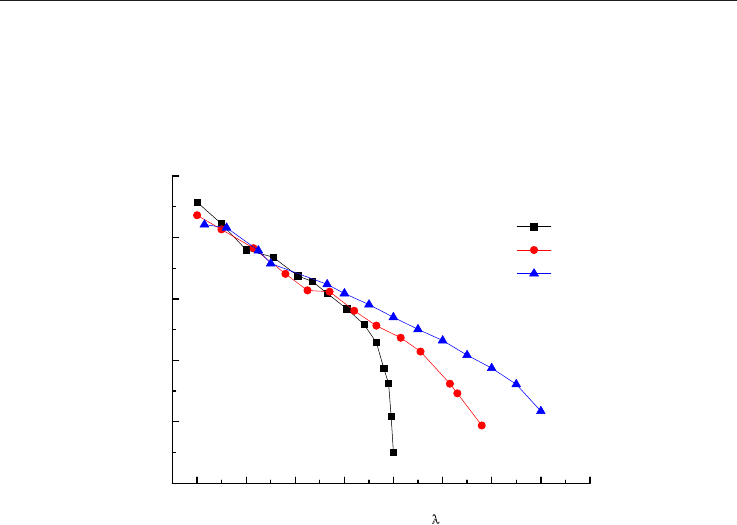
Hydrogen-enriched compressed natural gas as a fuel for engines 319
suitable hydrogen fraction is significantly related to ignition timing and excess air ratio.
According to Akansu et al. (2004) who completed tests on a single cylinder AVL engine at
hydrogen/natural gas ratio ranging from 0% to 100%, a 20–30% hydrogen enrichment of
natural gas gives the most favorable engine operation. Higher hydrogen contents
undermine the knock resistance characteristics of natural gas, lower power output of the
engine and increase the fuel cost. Akansu et al. also concludes that, Hydrogen content lower
than 20–30% does not make enough use of the performance enhancement potential of
hydrogen. (Akansu et al., 2004)
The thermal efficiency of fuel can be improved as seen in figure 2 from a previous section
and figure 12 of this section. Also seen in figure 12, the thermal efficiency begins to drop
rapidly after reaching a certain excess air ratio, for which this decline in thermal efficiency
can be reduced as the hydrogen ratio is increased. This is due to the improvements in
burning velocity and improvements in the combustion characteristics which can help extend
the lean burn limit and also improve the fuel efficiency. It can be seen in figure 6 that the
BSFC of the HCNG fuel can be reduced by increasing the ratio of hydrogen. The minimum
BSFC was attained using 40% HCNG, which results in a 5.07% lower BSFC than that of CNG
fueling at the same conditions.
1.0 1.2 1.4 1.6 1.8 2.0 2.2 2.4 2.6
0.15
0.20
0.25
0.30
0.35
0.40
Indicated thermal efficiency
Excess air ratio
0%
30
%
55
%
n=1200rpm MAP=105kPa MBT spark timing
Fig. 12. Indicated thermal efficiency versus excess air ratio
Under idle operation conditions, hydrogen addition is an effective method for improving
the power output of the engine and reducing both exhaust emissions and fuel consumption.
Furthermore, these results improve as the ratio of hydrogen is increased; however, studies
show that under ideal conditions there is not significant improvement when increasing the
hydrogen ratio in the HCNG fuel. Under normal operation conditions, the addition of
hydrogen is effective at improving the power output of the engine and reducing fuel
consumption. The hydrogen-enriched fuel can help improve the burning velocity and
improve the incomplete combustion and is seen to increase with the hydrogen ratio. Even
though the volumetric calorific value of the HCNG mixture is slightly lower than the
calorific value of pure CNG, after the fuel is enriched with hydrogen the combustion
efficiency and thermal power conversion efficiency are enhanced resulting in a higher
power performance as can be seen in figure 13.
1.0 1.2 1.4 1.6 1.8 2.0 2.2 2.4 2.6
10
20
30
40
50
60
n=1200rpm MAP=105kPa MBT spark timing
power output /kw
Excess air ratio
0% H
2
30% H
2
55% H
2
Fig. 13. Engine’s power performance versus excess air ratio
Figure 3 and figure 4 from a previous section show that the hydrogen addition can also be
an effective method to reduce the as coefficient of variation decreases. Cycle by cycle
variations are caused by poor burn quality and have many adverse effects such increasing
the emissions and reducing the performance. As the hydrogen fraction is increased, the
output torque also increases which can be seen in figure 5. According to Ma, et al. (2009a)
this is true at high engine speeds, but for low engine speeds the variation in torque is
negligible. Figure 14 shows the coefficient of variation of the indicated mean effective
pressure for different hydrogen ratios at different excess air ratios. As can be seen, hydrogen
addition can reduce COV
imep
especially when compared at high excess air ratios due to
hydrogen’s broader burn limit and its’ fast burn speed.
NOx emissions versus ignition timing were plotted in figure 7 of a previous section. As can
be seen from the figure, the NOx emissions increase as the hydrogen ratio increase. This is
caused by the elevated flame temperature in the cylinder which rises as the hydrogen is
added. Carbon monoxide emissions can also be greatly reduced with the addition of
hydrogen. Table 2 shows different hydrogen fractions while holding the power constant, it
is clearly seen in this table that as the hydrogen fraction is increased the carbon monoxide
and unburned hydrocarbon emissions are greatly reduced while the NOx remains at
acceptable levels. The reduction in hydrocarbon and carbon monoxide emissions can be
attributed to hydrogen’s ability to strengthen combustion, especially for lean fuel-air
mixtures.
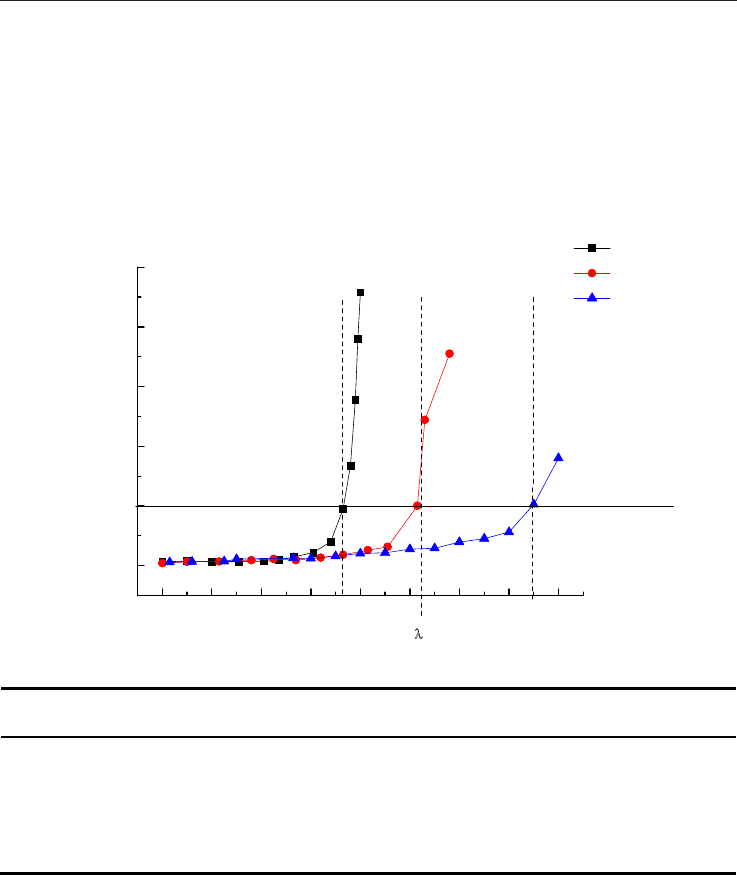
Natural Gas320
Regarding emissions, the largest advantage to using a higher hydrogen ratio is the reduction
in hydrocarbon emissions which can be seen in figure 10 of a previous section. The
reduction of hydrocarbon emissions can be explained by the fact that hydrogen can speed
up flame propagation and reduce quenching distance, thus decreasing the possibilities of
incomplete combustion, and because of the fact that the carbon concentration of the fuel
blends is decreased due to hydrogen addition. Hydrogen’s ability to strengthen combustion
has a large effect on the hydrocarbon emissions, which can be especially evident in lean fuel-
air mixtures.
1.0 1.2 1.4 1.6 1.8 2.0 2.2 2.4 2.6
0.0
0.1
0.2
0.3
0.4
0.5
COV
imep
/%
Excess air ratio
0% H
2
30% H
2
55% H
2
1200rpm MAP=105kPa MBT spark timin
g
=1.71
=2.09
=2.5
Fig. 14. COV
imep
versus excess air ratio
Hydrogen
fraction(%)
NOx
(%)
CH
4
(%)
CO
(%)
Economy
(%)
Power
(%)
0 100 100 100 100 100
10 67.2 84.3 90.4 97 100
20 50.4 71.1 82.7 92 100
30 64.3 65.3 76.5 93 100
40 88.6 60.1 71.3 94 100
50 105 57.3 67.3 94 100
Table 2. The overall performance of different hydrogen fraction at full load 1600r/min
Figures 15 confirms the improvements in flame development speed (characterized as the
duration between the spark and 10% mass fraction burned) and propagation speed
(characterized as the duration between 10% and 90% mass fraction burned). Fundamentally,
the addition of hydrogen provides a large pool of H and OH radicals whose increase makes
the combustion reaction much easier and faster, thus leading to shorter burn duration.
Engine performance and emissions at different hydrogen ratios are looked at in more detail
in Ma et al. (2008h) and Ma et al. (2010).
0.9 1.0 1.1 1.2 1.3 1.4 1.5 1.6 1.7 1.8 1.9 2.0 2.1 2.2 2.3 2.4 2.5 2.6
10
15
20
25
30
35
40
45
10%-90% MFB Burn Duration/CA deg
Excess air ratio
0% H
2
30% H
2
55% H
2
1200rpm MAP=105kPa MBT spark timing
=1.71
=2.09
=2.5
Fig. 15. 10% to 90% MFB burn duration versus excess air ratio
9.3 Spark Timing
Optimizing spark timing can be used as a strategy to avoid knocking and to avoid exceeding
the limit of maximum cylinder pressure when operating under lean burn conditions. An
effective way to reduce NOx emission is to retard the spark timing which can be seen in
figure 7 in a previous section. This is due to the combustion stability and the elevated flame
temperature in the cylinder. This figure shows an engine speed of 1600rpm, but at a lower
engine speed such as 800 rpm it is found that the NOx emissions also increase slightly when
the spark timing becomes closer to TDC beginning around 5 degrees CA BTDC. This is
because of the increased engine power loss when the ignition timing is set too close to TDC
because the fuel cannot burn completely and the combustion process mainly takes place in
the expansion stroke with a relatively low-pressure environment.
The thermal efficiency, shown in figure 16, is also greatly affected by the spark timing. As
can be seen in the figure, the thermal efficiency rises as the spark timing is advanced. This is
due to the decrease in temperature due to the early ignition timing. The performance and
emissions characteristics at different spark timings are more clearly explained in Ma et al.
(2008c).
